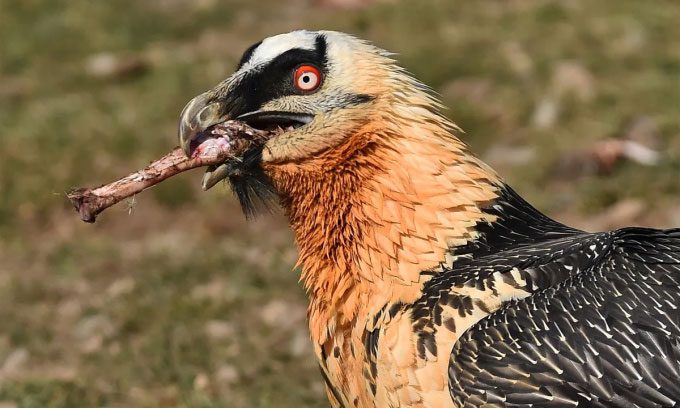With its large size, the bearded vulture impresses with its ability to consume bones and its red-tinted plumage from bathing in iron-rich mud springs.
The bearded vulture (Gypaetus barbatus) measures about 100 – 115 cm in height with a wingspan of 2.5 – 2.85 m, comparable to some large raptor species in North America. They have a striking appearance with an ivory-colored head, sharp eyes outlined in bright orange-red. Their keen eyes are further accentuated by a solid black feather stripe extending down to their beak, resembling a bandit’s mask. Below the beak is a tuft of bristly feathers, giving them the name bearded vulture.

The bearded vulture prefers to feed on animal bones. (Photo: Alberto Clemares Exposito).
As adults, bearded vultures primarily have dark gray and ivory-colored plumage. However, the feathers on their heads, chests, and legs are often stained with rusty orange due to their habit of bathing in iron-rich mud and sulfur springs.
According to the National Audubon Society, a non-profit environmental organization in the United States, there are two explanations for the bearded vulture’s red-staining bathing behavior.
- The first is to showcase their capabilities. The iron-rich springs are hidden in the mountains, so only the best birds can find them, thereby demonstrating their prowess to potential mates and rivals.
- The second explanation is that iron oxide helps combat bacteria, which is common in the carrion they prefer to consume.
Historically, bearded vultures were widely distributed across many mountain ranges in Africa, Europe, and Asia. In Europe, their habitat once spanned the southern mountain ranges of the continent, from western Spain through the Alps to the Balkan region. However, their current habitat in Europe is now limited to small areas in the Pyrenees and Sierra Nevada in Spain, as well as the Alps. Small populations of bearded vultures also inhabit the islands of Corsica and Crete in the Mediterranean. They are occasionally spotted in Western Europe, including the UK, although this is quite rare.

The bearded vulture has an impressive wingspan. (Photo: Andrea Vergani).
The bearded vulture is also known as Lammergeier, meaning “lamb vulture” in German, due to its tendency to prey on sheep. They are scavengers primarily targeting medium-sized ungulates such as sheep, goats, and ibex. However, meat is not their favorite food.
The bearded vulture is the only bird species in the world that primarily consumes bones, accounting for 85 – 90% of its diet. Their large and powerful talons are well adapted for breaking bones and extracting nutrition from the marrow inside. Bearded vultures also possess a stomach with extremely strong acids to digest bones. If a bone is too large to swallow whole, they will fly high and drop the bone onto rocky surfaces to break it into manageable pieces. For this reason, they are referred to as “quebrantahuesos” in Spanish, meaning “bone-breaker.”


















































